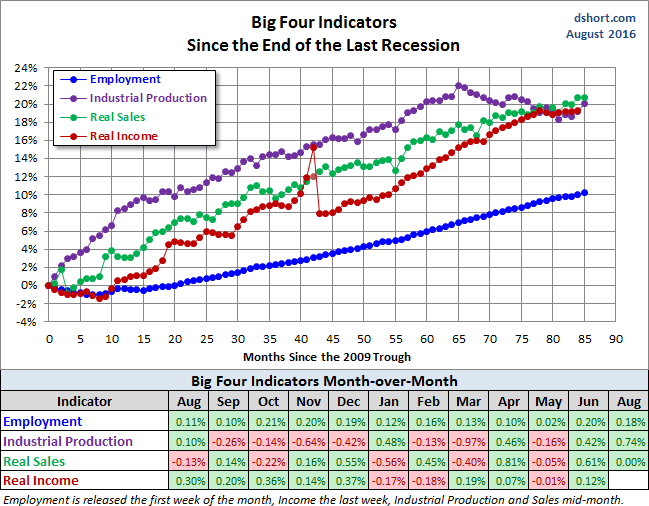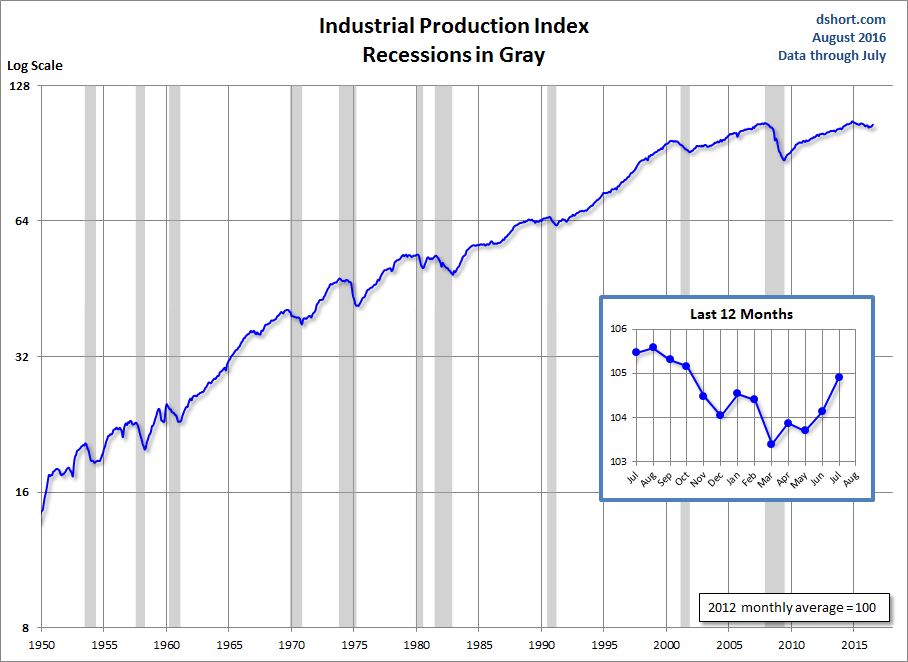Courtesy of Doug Short’s Advisor Perspectives.
Note: This commentary has been updated to include this morning’s release of Nonfarm Employment for April.
Official recession calls are the responsibility of the NBER Business Cycle Dating Committee, which is understandably vague about the specific indicators on which they base their decisions. This committee statement is about as close as they get to identifying their method.
There is, however, a general belief that there are four big indicators that the committee weighs heavily in their cycle identification process. They are:
- Nonfarm Employment
- Industrial Production
- Real Retail Sales
- Real Personal Income (excluding Transfer Receipts)
The Latest Indicator Data

This commentary has been updated to include Nonfarm Employment for April. As the adjacent thumbnail of the past year illustrates, Nonfarm Employment remains in its upward trend. However, the April report of 160K new jobs was substantially below expectations (Investing.com was looking for 202K). Furthermore, the February and March numbers were revised downward by 19K (12K and 7K, respectively).
The chart below shows the monthly percent change in this indicator since the turn of the century, a period that includes two recessions.

The Problem of Revisions
At first glance this indicator appears to have a strong correlation with the business cycle. However, there is a major problem with this assumption: The data in this survey of business establishments undergoes multiple revisions. The initial monthly estimate is subject to a first and second revision, subsequent benchmark revisions and annual revisions that stretch back many years (the most recent includes revisions back as far as February 1990). The cumulative size of the revisions is quite stunning, much of which is owing to the “hindsight” of those annual revisions.
The chart below measures the size of the revisions from the initial estimate to the latest employment report.

The downward revisions are absolutely astonishing.
The Problem of Population Growth
Another problem with the Nonfarm Employment data is that it isn’t adjusted for population growth, which reduces its usefulness in illustrating secular trends. The chart below incorporates a population adjustment by dividing the Nonfarm Employment (FRED series PAYEMS) by the Civilian Labor Force Age 16 and Over (FRED series CLF16OV). We’ve added a couple of trend lines and a callout — not to suggest a forecast but rather to highlight the potential impact of a near-term business-cycle downturn. Note also that the current level is about where we were at the end of 1997. The interim peak was in November of 2015.
The Generic Big Four
The chart and table below illustrate the performance of the generic Big Four with an overlay of a simple average of the four since the end of the Great Recession. The data points show the cumulative percent change from a zero starting point for June 2009.

Current Assessment and Outlook
The US economy has been slow in recovering from the Great Recession, and the overall picture has been a mixed bag for well over a year and counting. Employment and Income have been relatively strong. Real Retail Sales have essentially gone nowhere for the past ten months, and Industrial Production has essentially been in a recession.
The chart below illustrates the average of the Big Four percent is off its all-time high. The post-recession recovery peaked in November 2014, eighteen months ago. It is perhaps worth bearing in mind that the NBER’s most recent statement on US recession status (that we are not in a recession) is August 2014, three months before the current recovery peak.

The next update of the Big Four will be the Mid-May release of the April numbers for Industrial Production and Real Retail Sales.
Background Analysis: The Big Four Indicators and Recessions
The charts above don’t show us the individual behavior of the Big Four leading up to the 2007 recession. To achieve that goal, we’ve plotted the same data using a “percent off high” technique. In other words, we show successive new highs as zero and the cumulative percent declines of months that aren’t new highs. The advantage of this approach is that it helps us visualize declines more clearly and to compare the depth of declines for each indicator and across time (e.g., the short 2001 recession versus the Great Recession). Here is our four-pack showing the indicators with this technique.
Now let’s examine the behavior of these indicators across time. The first chart below graphs the period from 2000 to the present, thereby showing us the behavior of the four indicators before and after the two most recent recessions. Rather than having four separate charts, we’ve created an overlay to help us evaluate the relative behavior of the indicators at the cycle peaks and troughs. (See the note below on recession boundaries).
The chart above is an excellent starting point for evaluating the relevance of the four indicators in the context of two very different recessions. In both cases, the bounce in Industrial Production matches the NBER trough while Employment and Personal Incomes lagged in their respective reversals.
As for the start of these two 21st century recessions, the indicator declines are less uniform in their behavior. We can see, however, that Employment and Personal Income were laggards in the declines.
Now let’s look at the 1972-1985 period, which included three recessions — the savage 16-month Oil Embargo recession of 1973-1975 and the double dip of 1980 and 1981-1982 (6-months and 16-months, respectively).
And finally, for sharp-eyed readers who can don’t mind squinting at a lot of data, here’s a cluttered chart from 1959 to the present. That is the earliest date for which all four indicators are available. The main lesson of this chart is the diverse patterns and volatility across time for these indicators. For example, retail sales and industrial production are far more volatile than employment and income.
History tells us the brief periods of contraction are not uncommon, as we can see in this big picture since 1959, the same chart as the one above, but showing the average of the four rather than the individual indicators.
The chart clearly illustrates the savagery of the last recession. It was much deeper than the closest contender in this timeframe, the 1973-1975 Oil Embargo recession. While we’ve yet to set new highs, the trend has collectively been upward, although we have that strange anomaly caused by the late 2012 tax-planning strategy that impacted the Personal Income.
Here is a close-up of the average since 2000.
Appendix: Chart Gallery with Notes
Each of the four major indicators discussed in this article are illustrated below in three different data manipulations:
- A log scale plotting of the data series to ensure that distances on the vertical axis reflect true relative growth. This adjustment is particularly important for data series that have changed significantly over time.
- A year-over-year representation to help, among other things, identify broader trends over the years.
- A percent-off-high manipulation, which is particularly useful for identifying trend behavior and secular volatility.
Total Nonfarm Employees
There are many ways to plot employment. The one referenced by the Federal Reserve researchers as one of the NBER indicators is Total Nonfarm Employees (PAYEMS).
Industrial Production
The US Industrial Production Index (INDPRO) is the oldest of the four indicators, stretching back to 1919, although we’ve dropped the earlier decades and started in 1950.
Real Retail Sales
This indicator is a splicing of the discontinued retail sales series (RETAIL, discontinued in April 2001) with the Retail and Food Services Sales (RSAFS) and deflated by the seasonally adjusted Consumer Price Index (CPIAUCSL). We’ve used a splice point of January 1995 because that date was mentioned in the FRED notes. Our experiments with other splice techniques (e.g., 1992, 2001 or using an average of the overlapping years) didn’t make a meaningful difference in the behavior of the indicator in proximity to recessions. We’ve chained the data to the latest value for the CPI.
Real Personal Income Less Transfer Receipts
This data series is computed by taking Personal Income (PI) less Personal Current Transfer Receipts (PCTR) and deflated using the Personal Consumption Expenditure Price Index (PCEPI). We’ve chained the data to the latest price index value.
The “Tax Planning Strategies” annotation refers to shifting income into the current year to avoid a real or expected tax increase.
Transfer Payments largely consist of retirement and disability insurance benefits, medical benefits, income maintenance benefits (more here).
The chart below shows the Transfer Payment portion of Personal Income. We’ve included recessions to help illustrate the impact of the business cycle on this metric.

A Note on Recessions: Recessions are represented as the peak month through the month preceding the trough to highlight the recessions in the charts above. For example, the NBER dates the last cycle peak as December 2007, the trough as June 2009 and the duration as 18 months. The “Peak through the Period preceding the Trough” series is the one FRED uses in its monthly charts, as explained in the FRED FAQs illustrated in this Industrial Production chart.






















